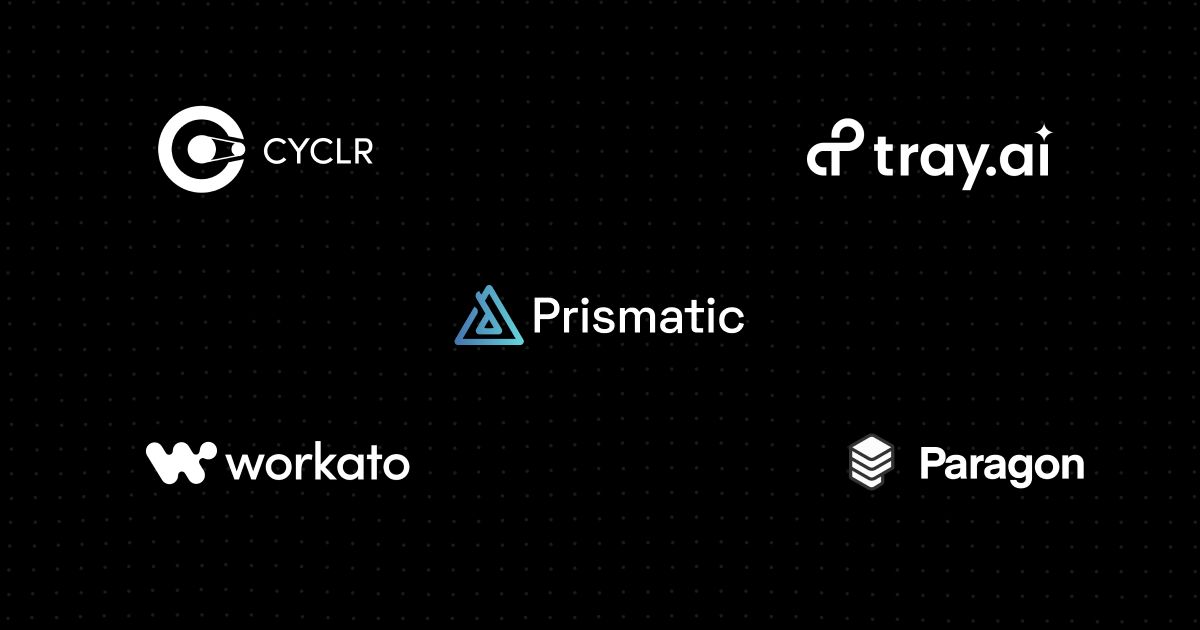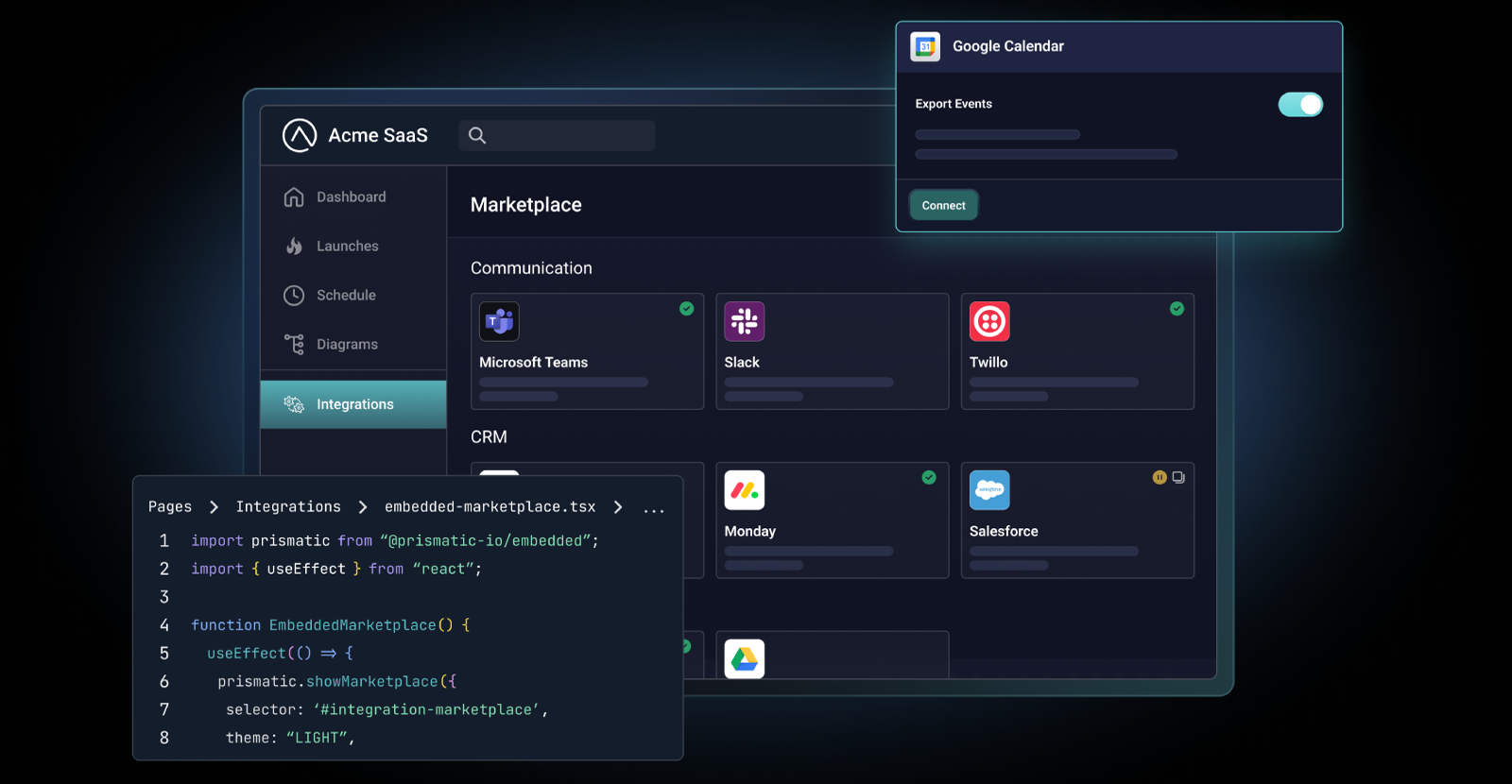Integration platforms have been in the market for a long time. However, they focus on the traditional iPaaS scenario: building internal integrations to automate workflow inside companies. Unfortunately, these products aren't well suited for B2B SaaS companies – which have an existential need to need to build integrations.
Fortunately, we have B2B SaaS integration platforms purpose-built for B2B SaaS companies. Just a few years ago, only a handful of people knew what these platforms were or what value they could provide.
Since then, this category has gained a name (embedded iPaaS or embedded integration platform) and a growing following.
B2B SaaS integrations platforms were created to help thousands of SaaS companies build integrations from their products to their customers' other applications. With the average mid-sized company using hundreds of apps, building B2B SaaS integrations for everyone who needs them can be challenging.
Why are B2B SaaS integrations so hard?
Anyone who works in software knows that integrations are far harder than they look. You are not alone if you are running into challenge after challenge with your B2B SaaS integrations. Here at Prismatic, our experience tells us that many SaaS companies continue to struggle with integrations. In the following sections, we'll look at why this is true.
Loss of focus on your core SaaS product
Integrations can take over your B2B SaaS dev team and keep them from progressing on your core product. This happens regularly because of sheer numbers. You have your core SaaS application, but your customers may need integrations from your product to dozens of different apps.
In an attempt to keep integration development from getting out of hand, it's not uncommon for dev teams to build integrations with the absolute minimum functionality, including no user config, little to no messaging/error handling, and no actual UI. As a result, these integrations become unpolished bolt-ons to your product rather than first-class features.
Innate integration complexity
While some integrations are simple data imports or exports, many integrations are complex. They may connect three or more systems, send many different messages, and or require substantial data manipulation and logic operations to convert the input data to the output data.
Integration requirements often start simple. "Transfer order data from X to Y daily." But when we break things down, the complexity appears. What is "order data"? Can it all be found in the same table in X? Are both systems using the same data format? Are we only transferring new orders (created since the last time the integration ran), or should we also transfer updated or deleted orders? And the list goes on.
Need for configurability
Another reason SaaS integrations are hard is that they often need to be highly configurable. Traditionally, this has meant that companies built an integration, made dozens of copies of that integration, and then modified each one to suit a particular customer. Then, when the base integration required a global change, the team would need to update each customer's integration individually and redeploy it.
Taking this road leads to massive support headaches and much time wasted creating and managing numerous integrations that are 95% identical but need to be treated as though they don't share any code at all.
How to build, deploy and support integrations for happy customers
As you might guess, building numerous (often complex) integrations and managing customer configuration requirements isn't sustainable using the traditional, one-off approach to building integrations. And that is why we have B2B SaaS integration platforms.
B2B SaaS integration platforms provide everything your devs (and non-devs) need to build, deploy, and support integrations for all your customers. And they do so in a way that provides your customers with a wonderful user experience.
Building integrations
A B2B SaaS integration platform helps you shift the responsibility of building integrations off your devs. It does this by including a low-code integration designer and pre-built API connectors (and other components). Together, these tools allow non-devs to assemble integrations for many scenarios.
In addition, the platform includes the ability for your devs to write any additional code that might be needed for an integration scenario. That way, if you run into limitations with the low-code designer when the integration is 90% done, your devs can write code for that last 10%.
Finally, an embedded workflow builder enables your customers to create their own integrations between your product and other apps they use. This allows you to say "yes" to highly-specific integration needs without having to spend dev time building and maintaining bespoke integrations that don't benefit your broader customer base.
Deploying integrations
Beyond simplifying and accelerating your build process, a B2B integration platform also includes the tools necessary to configure and deploy your product's integrations. As with building integrations, you can have your non-devs handle most configuration and deployment needs.
The platform provides an integration marketplace where customers can view, sort, and select their desired integrations. You can even set up the marketplace so customers can turn on the integrations they want all by themselves.
Supporting integrations
The B2B integration platform also simplifies your integration support. Non-devs can perform most support functions; customers can even do first-level support of their integrations.
Meanwhile, the infrastructure on which the integrations are deployed does its job in the background. Security, reliability, and scaling are handled for you, removing an entire class of possible support tickets from consideration.
Ensuring a wonderful UX
We've not talked in detail about the user experience, but using an integration platform brings visibility and control to the integration UX that would otherwise be missing. From the embedded integration marketplace to the integration configuration to the ability to access logs and notifications for troubleshooting, the B2B SaaS integration platform helps to ensure that your product's user experience doesn't stop where the integration starts.
B2B SaaS integration FAQs
Question: How does a B2B SaaS integration platform differ from an iPaaS?
Answer: A traditional iPaaS (enterprise iPaaS) is a general-purpose platform used by businesses to create integrations for internal use. However, a B2B SaaS integration platform (embedded iPaaS) is a purpose-built platform software companies use to create native product integrations for their customers. Both are for building integrations, but their use cases diverge widely.
Question: Couldn't my team build all that integration platform functionality?
Answer: Absolutely. Perhaps a better question would be, "should they?" Given sufficient time and resources, your team could build anything. But, a third-party B2B SaaS integration platform is a force multiplier for your integrations. Just as you probably wouldn't create your own identity management or payments system, using an integration platform designed explicitly for B2B SaaS products makes sense.
Question: I've worked with low-code systems before and wasn't impressed. How is this different?
Answer: Many low-code systems fall short because they are low-code only. A well-designed B2B SaaS integration platform has a low-code designer but also allows devs to write whatever code is needed. Not only that, but they can tie the platform into your current dev processes, including code versioning.
Getting on the platform
B2B SaaS integrations are essential. At the same time, they are hard to do well. The number and complexity of integrations needed for B2B SaaS products keep increasing. And customers expect these integrations to be configured to their exact needs while being essentially bulletproof.
A B2B SaaS integration platform provides stability and scalability, essential to establishing a sustainable approach to B2B SaaS integration development and support.
The stability comes from using tools and infrastructure designed to build and deploy integrations. Scalability comes from managing dozens (or hundreds) of integrations from a single tool while ensuring each customer has uniquely appropriate configuration options.
If stability and scalability would benefit your B2B SaaS integration project, schedule a demo, and we'll show you how an embedded integration platform can help your product connect with customers.




